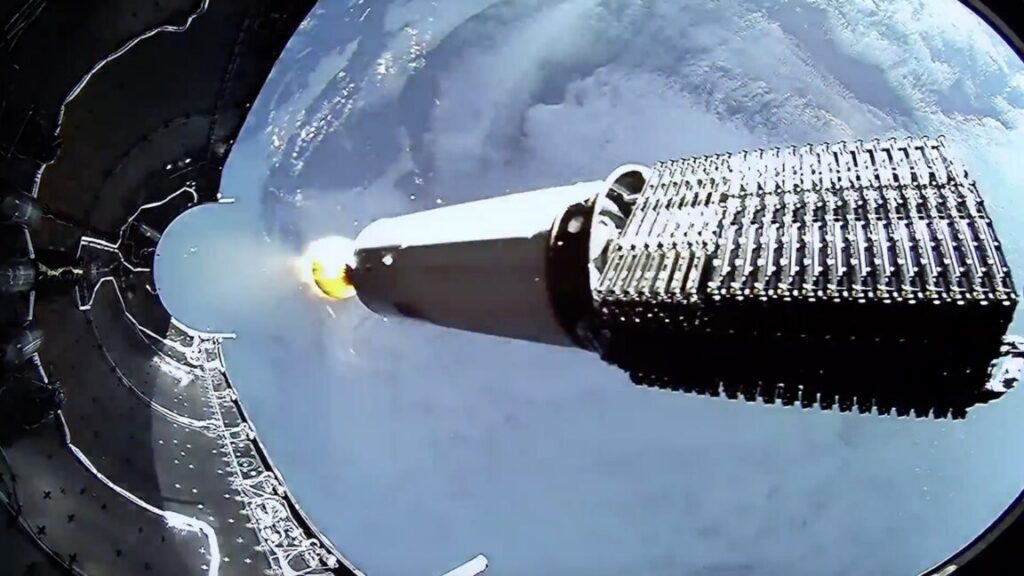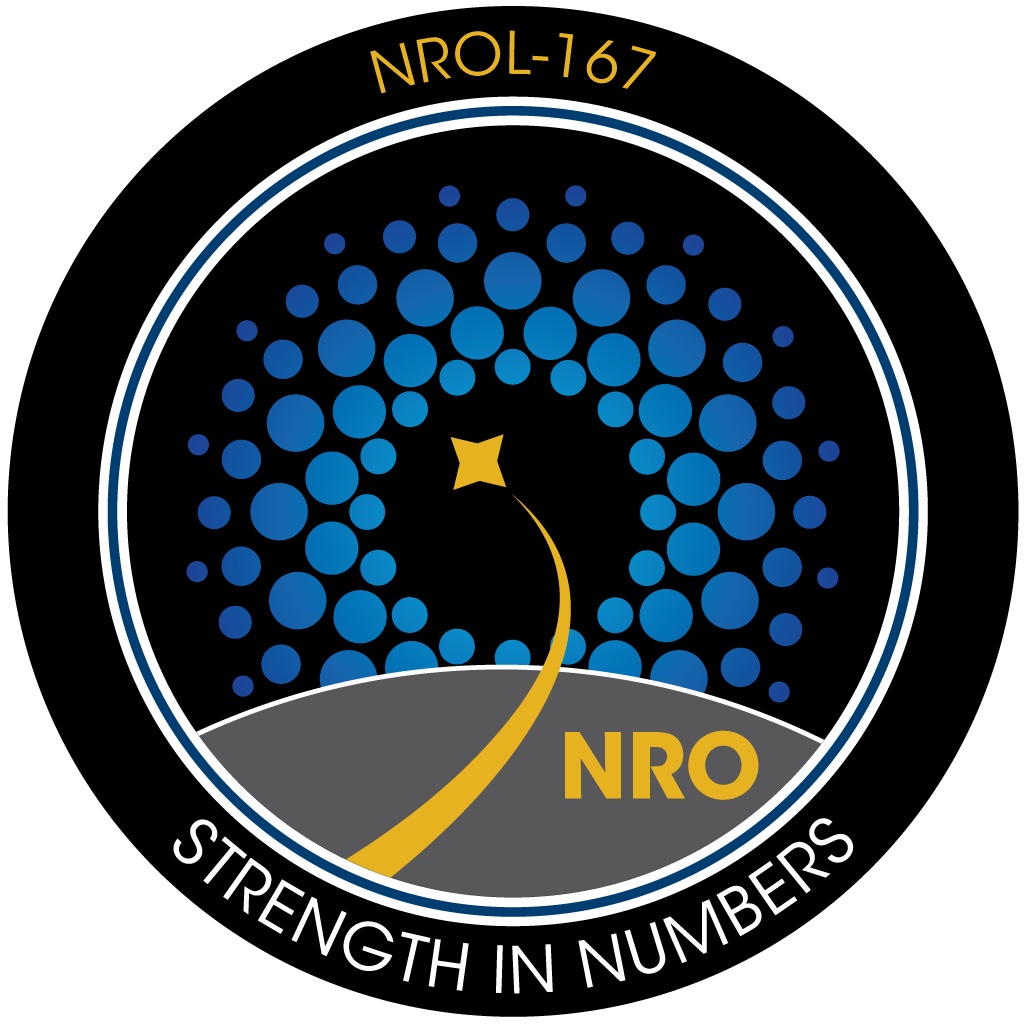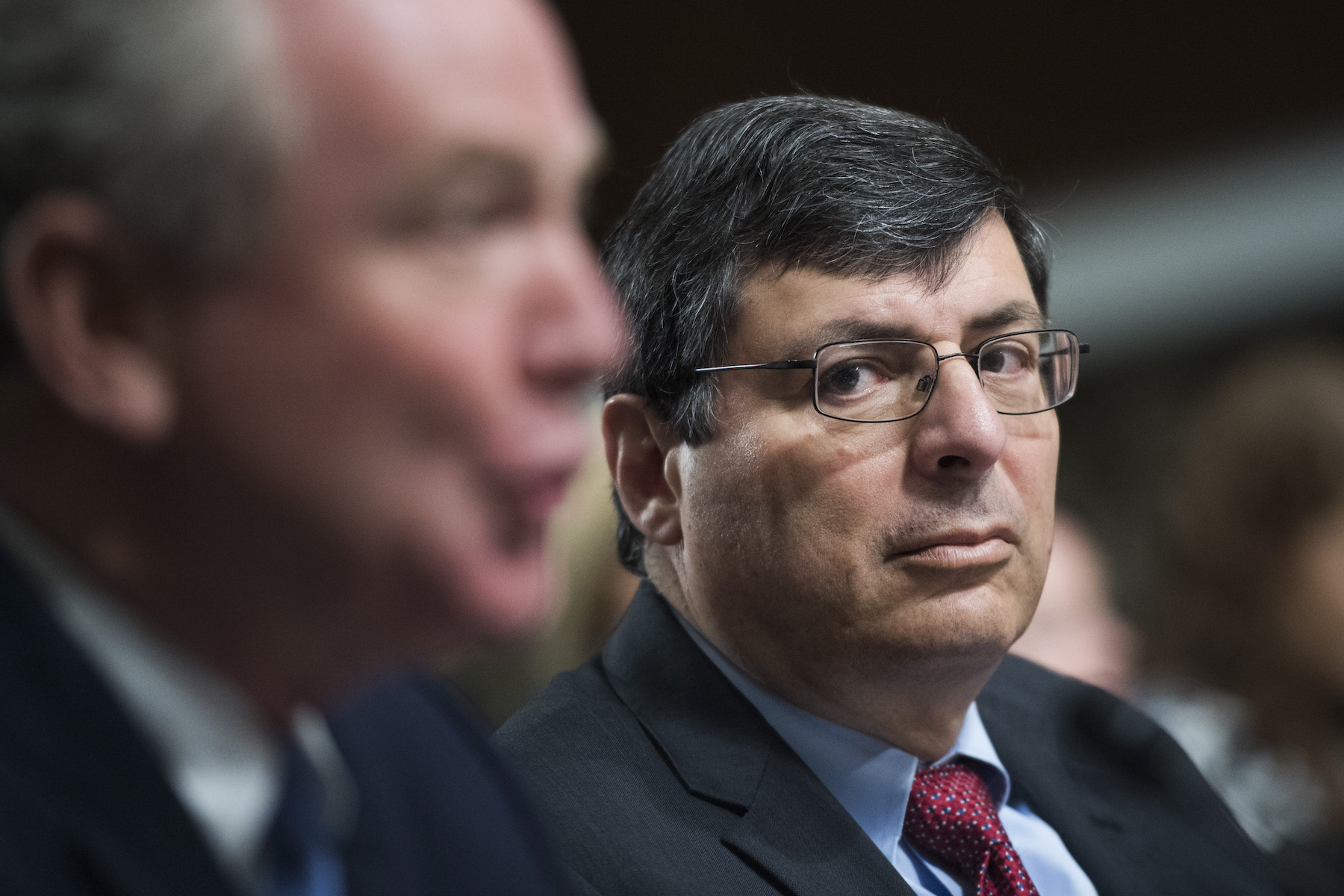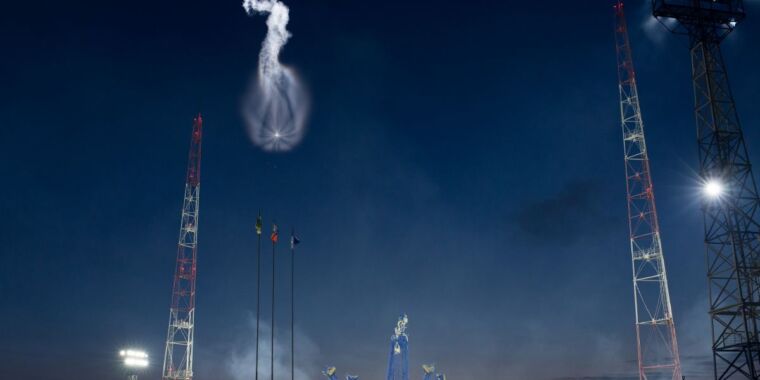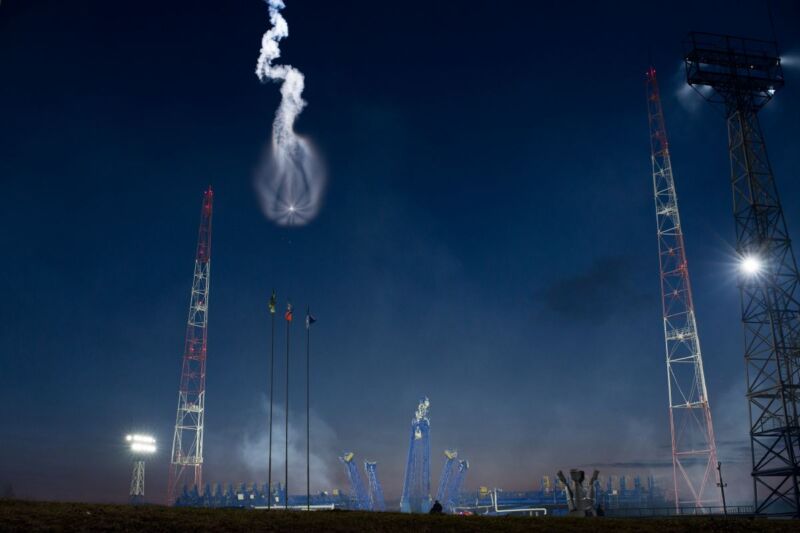NRO chief: “You can’t hide” from our new swarm of SpaceX-built spy satellites
“A satellite is always coming over an area within a given reasonable amount of time.”
This frame from a SpaceX video shows a stack of Starlink Internet satellites attached to the upper stage of a Falcon 9 rocket, moments after jettison of the launcher’s payload fairing. Credit: SpaceX
The director of the National Reconnaissance Office has a message for US adversaries around the world.
“You can’t hide, because we’re constantly looking,” said Chris Scolese, a longtime NASA engineer who took the helm of the US government’s spy satellite agency in 2019.
The NRO is taking advantage of SpaceX’s Starlink satellite assembly line to build a network of at least 100 satellites, and perhaps many more, to monitor adversaries around the world. So far, more than 80 of these SpaceX-made spacecraft, each a little less than a ton in mass, have launched on four Falcon 9 rockets. There are more to come.
A large number of these mass-produced satellites, or what the NRO calls a “proliferated architecture,” will provide regularly updated imagery of foreign military installations and other sites of interest to US intelligence agencies. Scolese said the new swarm of satellites will “get us reasonably high-resolution imagery of the Earth, at a high rate of speed.”
This is a significant change in approach for the NRO, which has historically operated a smaller number of more expensive satellites, some as big as a school bus.
“We expect to quadruple the number of satellites we have to have on-orbit in the next decade,” said Col. Eric Zarybnisky, director of the NRO’s office of space launch, during an October 29 presentation at the Wernher von Braun Space Exploration Symposium in Huntsville, Alabama.
The NRO is not the only national security agency eyeing a constellation of satellites in low-Earth orbit. The Pentagon’s Space Development Agency plans to kick off a rapid-fire launch cadence next year to begin placing hundreds of small satellites in orbit to detect and track missiles threatening US or allied forces. The Space Force is also interested in buying its own set of SpaceX satellites for broadband connectivity.
The Pentagon started moving in this direction about a decade ago, when leaders raised concerns that the legacy fleets of military and spy satellites were at risk of attack. Now, Elon Musk’s SpaceX and a handful of other companies, many of them startups, specialize in manufacturing and launching small satellites at relatively low cost.
“Why didn’t we do this earlier? Well, launch costs were high, right?” said Troy Meink, the NRO’s principal deputy director, in an October 17 discussion hosted by the Mitchell Institute for Aerospace Studies. “The cost of entry was pretty high, which has come way down. Then, digital electronics has allowed us to build capability in a much smaller package, and a combination of those two is really what’s enabled it.”
A constant vigil
NRO officials still expect to require some large satellites with sharp-eyed optics—think of a Hubble Space Telescope pointed at Earth—to resolve the finest details of things like missile installations, naval fleets, or insurgent encampments. The drawback of this approach is that, at best, a few big optical or radar imaging satellites only fly over places of interest several times per day.
With the proliferated architecture, the NRO will capture views of most places on Earth a lot more often. Two of the most important metrics with a remote-sensing satellite system are imaging resolution and revisit time, or how often a satellite is over a specific location on Earth.
“We need to have persistence or fast revisit,” Scolese said on October 3 in a discussion at the Center for Strategic and International Studies, a nonprofit Washington think tank. “You can proliferate your architecture, put more satellites up there, so that a satellite is always coming over an area within a given reasonable amount of time that’s needed by the users. That’s what we’re doing with the proliferated architecture.
“That’s enabled by a really rich commercial industry that’s building hundreds or thousands of satellites,” Scolese said. “That allowed us to take those satellites, adapt them to our use at low cost, and apply whatever sensor is needed to go off and acquire the information that’s needed at whatever revisit time is required.”
The NRO’s logo for its proliferated satellite constellation, with the slogan “Strength in Numbers.” Credit: National Reconnaissance Office
The NRO has identified other benefits, too. It’s a lot more difficult for a country like Russia or China to take out an entire constellation of satellites than to destroy or disable a single spy platform in orbit. Military officials have often referred to these expensive one-off satellites as “big juicy targets” for potential adversaries.
“It gives us a degree of resilience that we didn’t have before,” Scolese said.
The proliferated constellation also allows the NRO to be more nimble in responding to threats or new technologies. If a new type of sensor becomes available, or an adversary does something new that intelligence analysts want to look at, the NRO and its contractor can quickly swap out payloads on satellites going through the production line.
“That’s a huge change for an organization like the NRO,” Zarybnisky said. “It’s a catalyst. Another catalyst for innovation in the NRO is these smaller, lower price-point systems. Rapid turn time means you can introduce that next technology into the next generation and not wait for many years or even decades to introduce new technologies.”
Three-letter agencies
The NRO provides imaging, signals, and electronic intelligence data from its satellites to the National Security Agency, the National Geospatial-Intelligence Agency, and the Department of Defense. Scolese said the NRO wants to get actionable information into the hands of users across the federal government as quickly as possible, but the volume of data coming down from hundreds of satellites presents a challenge.
“Once you go to a proliferated architecture and you’re going from a few satellites to tens of satellites to now hundreds of satellites, you have to change a lot of things, and we’re in the process of doing that,” Scolese said.
With so many satellites, it “means that it’s no longer possible for an individual sitting at a control center to say, ‘I know what this satellite is doing,'” Scolese said. “So we have to have the machines to go off and help us there. We need artificial intelligence, machine learning, automated processes to help us do that.”
“We will deliver data in seconds, not minutes, and not hours,” Zarybnisky said.
The existence of this constellation was made public in March, when Reuters reported the NRO was working with SpaceX to develop and deploy a network of satellites in low-Earth orbit. SpaceX’s Starshield business unit is building the satellites under a $1.8 billion contract signed in 2021, according to Reuters. This is remarkably inexpensive by the standards of the NRO, which has spent more money just constructing a satellite processing facility at Cape Canaveral, Florida (thanks to Eric Berger’s reporting in Reentry for this juicy tidbit).
Chris Scolese appears before the Senate Armed Services Committee in 2019 during a confirmation hearing to become director of the National Reconnaissance Office. Credit: Tom Williams/CQ Roll Call
Reuters reported Northrop Grumman is supplying sensors to mount on at least some of the SpaceX-built satellites, but their design and capabilities remain classified. The NRO, which usually keeps its work secret, officially acknowledged the program in April, a month before the first batch of satellites launched from Vandenberg Space Force Base, California.
SpaceX revealed the existence of the Starshield division in 2022, the year after signing the NRO contract, as a vehicle for applying the company’s experience manufacturing Starlink Internet satellites to support US national security missions. SpaceX has built and launched more than 7,200 Starlink satellites since 2019, with more than 6,000 currently operational, 10 times larger than any other existing satellite constellation.
The current generation of Starlink satellites launch in batches of 20 to 23 spacecraft on SpaceX’s Falcon 9 rocket. They’re flat-packed one on top of the other inside the Falcon 9’s payload shroud, then released all at once in orbit. The NRO’s new satellites likely use the same basic design, launching in groups of roughly 21 satellites on each mission.
According to Scolese, the NRO owns these SpaceX-built satellites, rather than SpaceX owning them and supplying data to the government through a service contract arrangement. By the end of the year, the NRO’s director anticipates having at least 100 of these satellites in orbit, with additional launches expected through 2028.
“We are going from the demo phase to the operational phase, where we’re really going to be able to start testing all of this stuff out in a more operational way,” Scolese said.
The NRO is buttressing its network of government-owned satellites with data buys from commercial remote-sensing companies, such as Maxar, Planet, and BlackSky. One advantage of commercial imagery is the NRO can share it widely with allies and the public because it isn’t subject to top-secret classification restrictions.
Scolese said it’s important to maintain a diversity of sources and observation methods to overcome efforts from other nations to hide what they’re doing. This means using more satellites, as the NRO is doing with SpaceX and other commercial partners. It also means using electro-optical, radar, thermal infrared, and electronic detection sensors to fully characterize what intelligence analysts are seeing.
The NRO is also studying more exotic methods like quantum remote sensing, using the principles of quantum physics at the atomic level.
“There’s camouflage,” Scolese said. “There are lots of techniques that can be used, which means we have to go off and look at very different phenomenologies, and we’ve developed and are developing capabilities that will allow us to defeat those types of activities. Quantum sensing is one of them. You can’t really hide from fundamental physics.”
NRO chief: “You can’t hide” from our new swarm of SpaceX-built spy satellites Read More »
